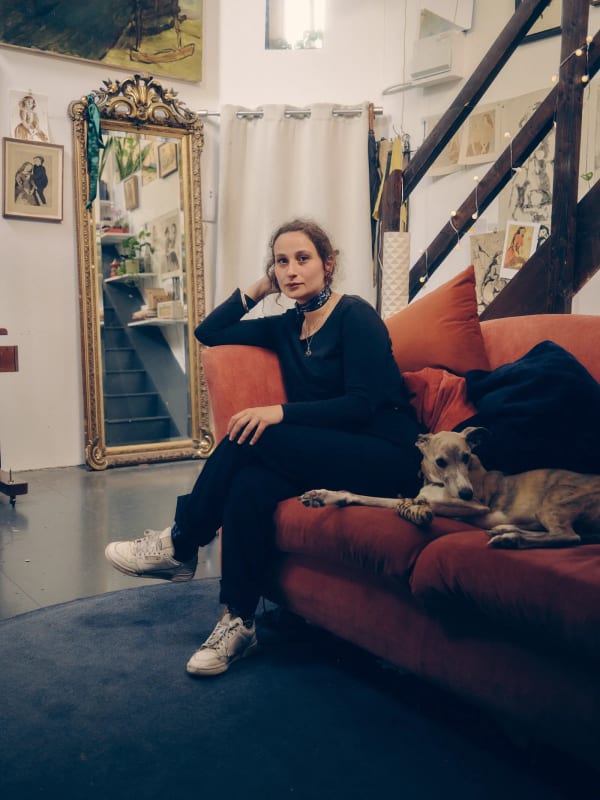The stars of Liorah Tchiprout’s captivating paintings are her characterful handmade dolls, which she arranges in brooding tableaux. These beguiling figurine fantasias are currently the subject of an exhibition at Pippy Houldsworth Gallery
Liorah Tchiprout does not make studies from life. Instead, the young London artist constructs exquisite dolls adorned in minuscule jewellery and delicate scraps of fabric, inspired by female protagonists from Yiddish literature, as well as more personal references. They are then set in a realm of tiny furniture and other mini accoutrements, forming tableaux that, when dramatically lit by an array of poseable lamps, result in a theatrical and occasionally eerie chiaroscuro that she uses to inform her final compositions in oil paint and etching.
Tchiprout mounts these gorgeous dioramas in her north London studio, where she lives and works. Here, the transition between her art production and broader home life feels utterly seamless. This former industrial unit is demarcated by a sun-drenched mezzanine, which serves as airy sleeping quarters and features a much-coveted door to an open rooftop. The shaft of light that emanates from this platform practically spotlights the second-hand easel below, while the rest of the ground floor inhabits a mild, comforting gloom. Throughout the day, it is illuminated by an array of candles and wax melts that the artist makes herself.
‘The easel was a gift from an artist’s widow who wanted it to go to good use,’ she explains. ‘As you can see, it certainly does!’ Indeed, the accompanying palette is piled high with impastoed layers of pigment and crumpled paint tubes, which relate directly to the enormous oil-on-board pieces that are hung on the wall above. They form part of a new body of work now on show at Pippy Houldsworth Gallery until 28 September.
This is by no means the only item to be passed on to the artist, who has populated much of the space with pieces donated by her former employer and mentor of sorts, John Phillips. When he closed the influential London Print Studio in 2020, he gave her several items that might seem at odds with a trade space, including a large, gilded mirror and an ornately carved chest of drawers. Of the latter, she explains, ‘It once belonged to the daughter of [a maharajah] in India, but the piece couldn’t be sold, because it is inlaid with ivory.’ It sits in surprisingly comfortable dialogue with a free-standing kitchen comprising zesty-yellow Formica units – a joyful 1960s relic bought for a song online.
Among stacks of art supplies and some impressive mahogany wardrobes there is also a beautiful Hunter Penrose etching press, bought with the proceeds of the Sunny Dupree Family Award for a Woman Artist, which she won in 2023. ‘I know so many people in the world of print, and some friends heard of a studio closing in Southampton who were offloading their press. It has always been a dream to have my own,’ she reveals.
Although she originally studied printmaking, Tchiprout’s practice is far more expansive. The disassembled remnants of a theatrical set allude to a former exhibition, which was informed by her study of puppetry and its connections with Ashkenazi Jewish traditions. The space is also littered with trinkets that make their way into her work. ‘I often wonder how this fits into my practice. Am I just hoarding?’ she asks with a laugh, while gesturing to her collected piles of minuscule wine bottles, music stands, tables, chairs, miniature canvases and a plastic toy lurcher, which emulates her own charismatic hound stretched out on a dusky-pink sofa nearby.
Tchiprout’s voracious collecting habits mirror her myriad artistic influences, which are evident not only in her book collection, but the vast selection of postcards, posters and prints that festoon her walls, depicting everything from portraits by Sargent and Bronzino to prints by RB Kitaj and Paula Rego.
Although she once felt defined by a singular medium, experiments in painting during lockdown (and their subsequent sales) inspired her to think far more expansively. With no formal training, she entered a competition to win a pack of ‘beginner’ oil paints and asked a friend for advice on the best shades to start out with. The gamble certainly paid off. Her paintings are formed of delicately built, almost iridescent layers and are infused with the quiet confidence of an artist who has a long-standing obsession with drawing, not to mention years of technical experience among mordants and inks. ‘I still have to pinch myself sometimes,’ she says. ‘I get to wake up and make art every day. What could be more magical than that?’

